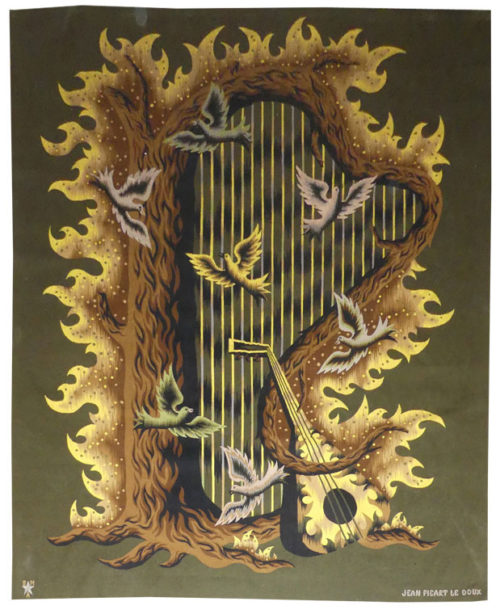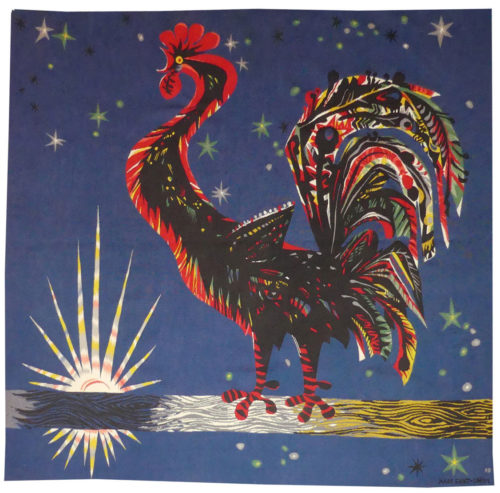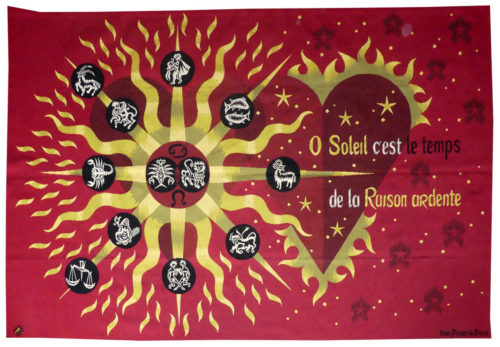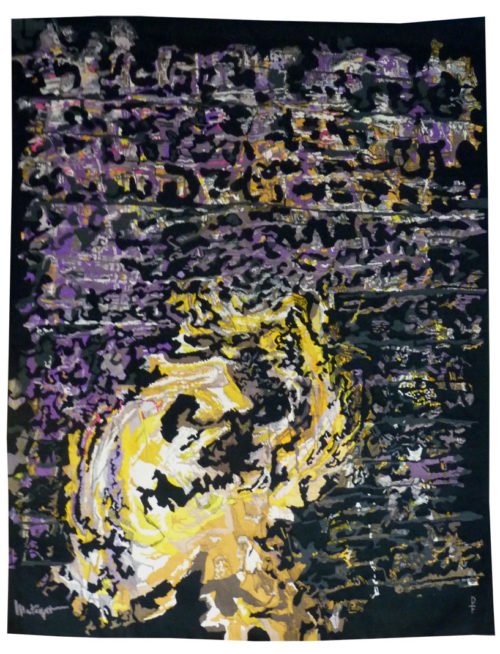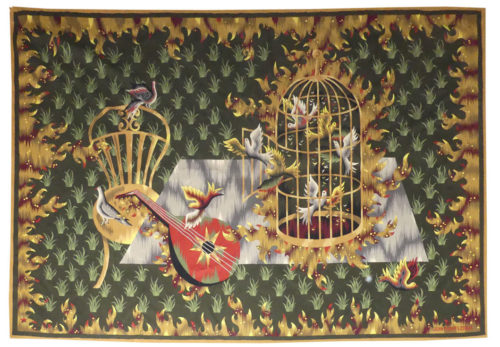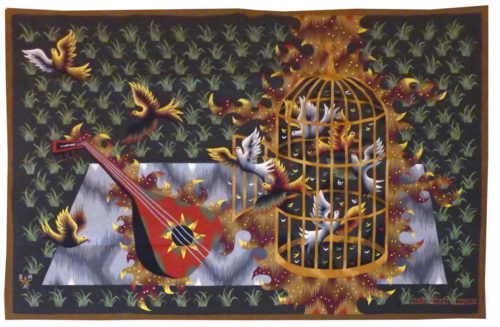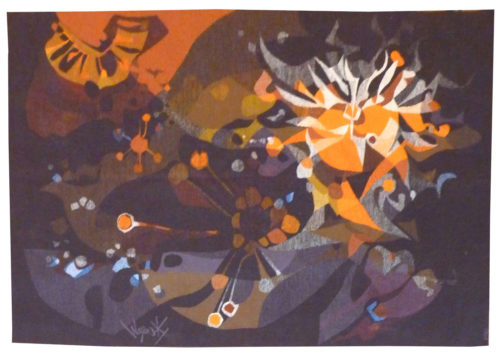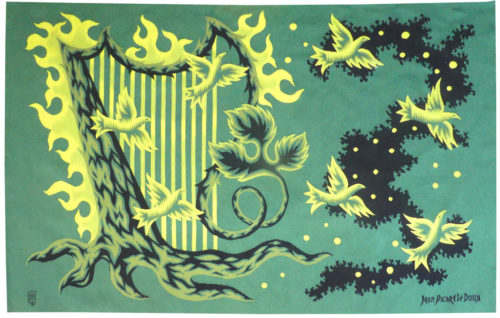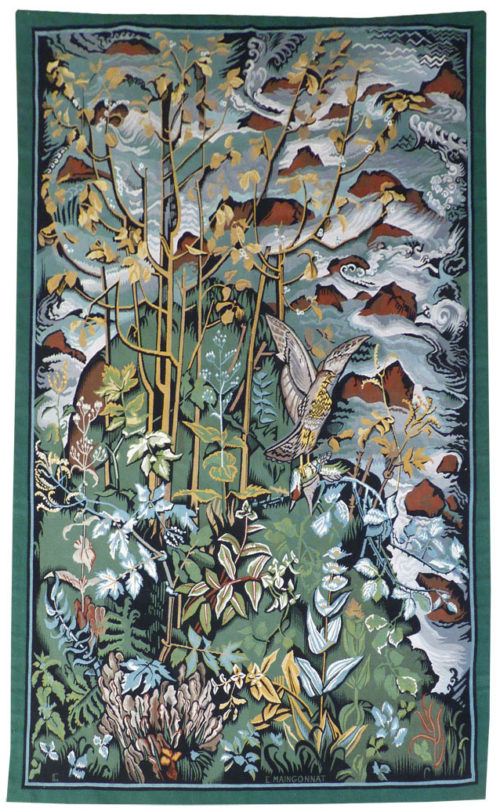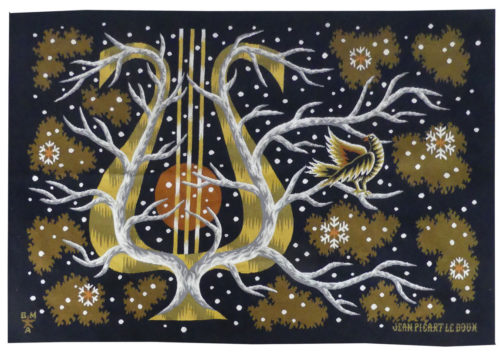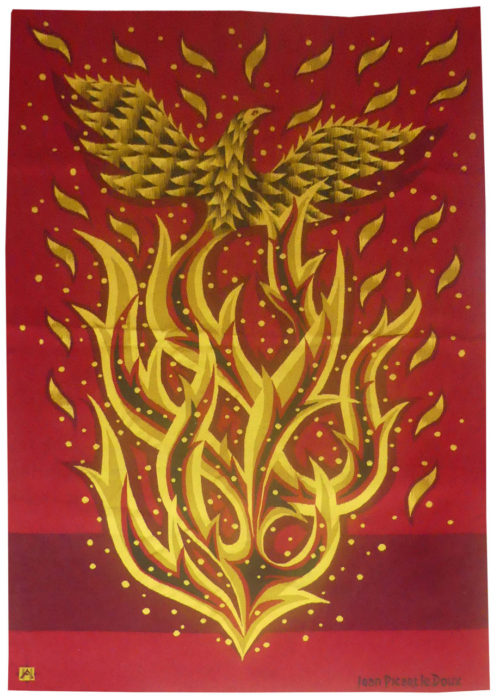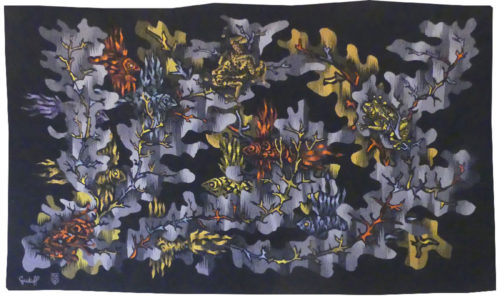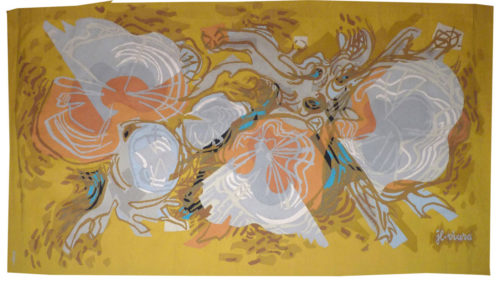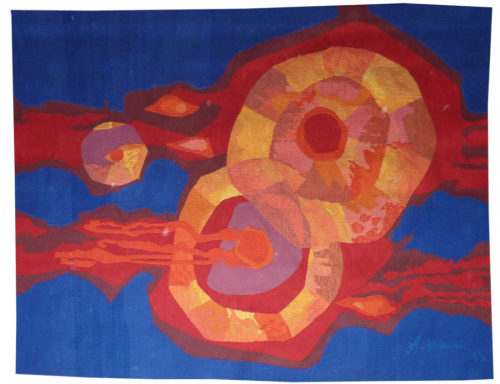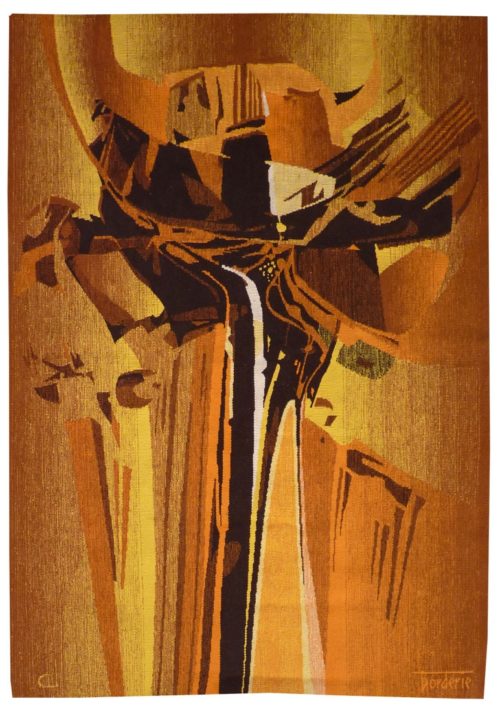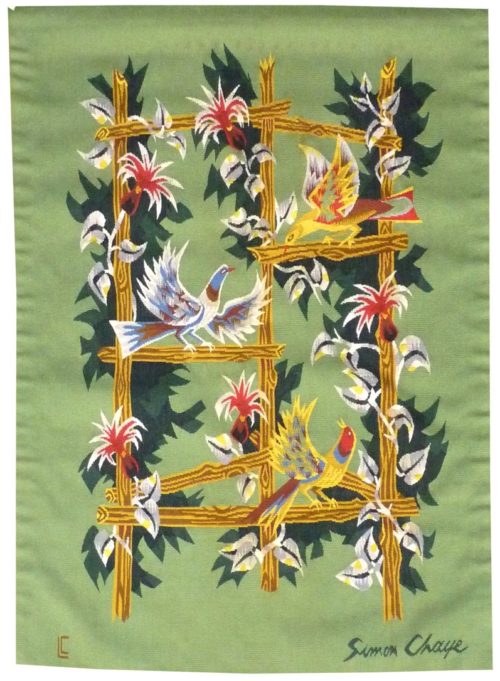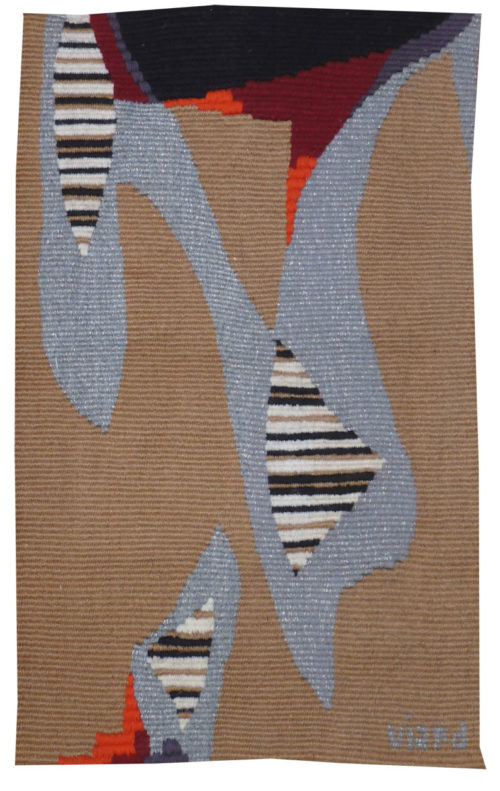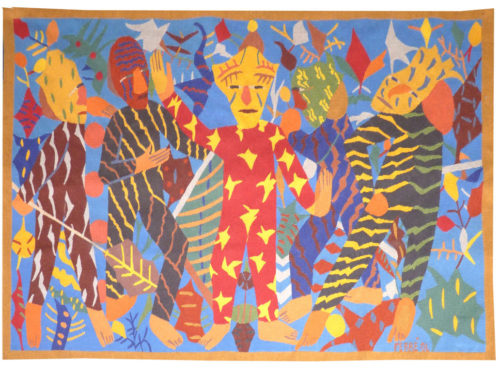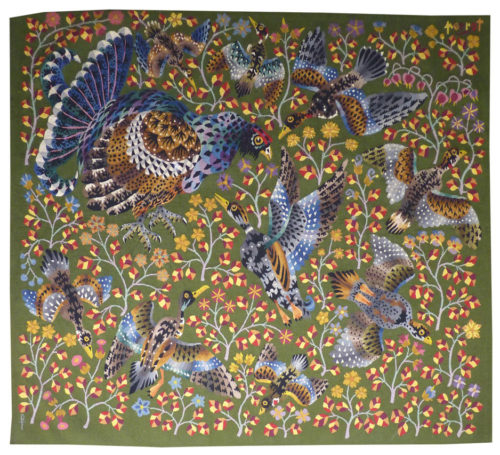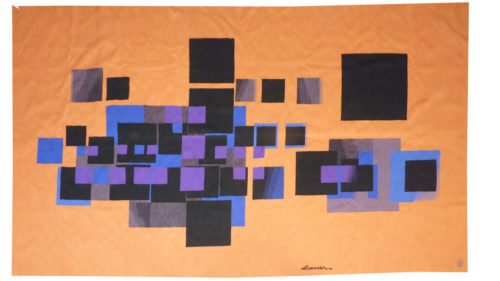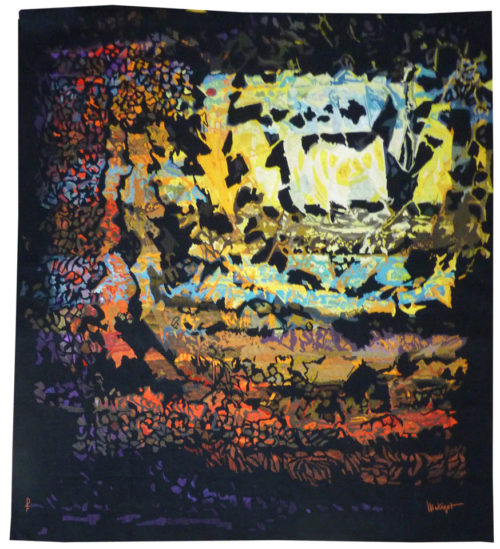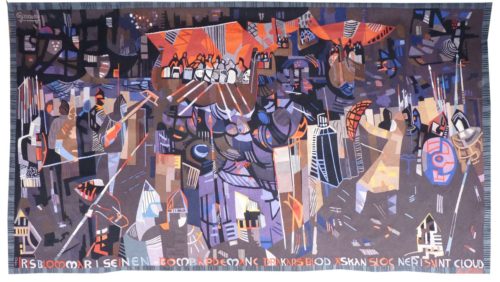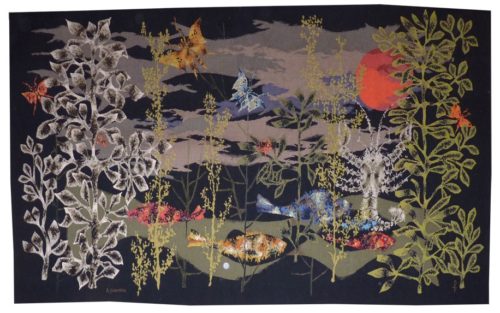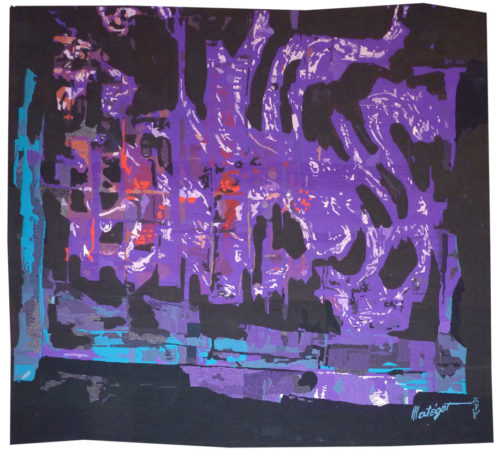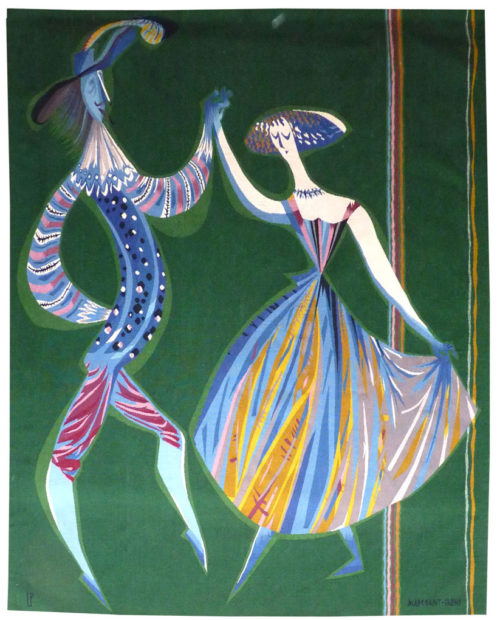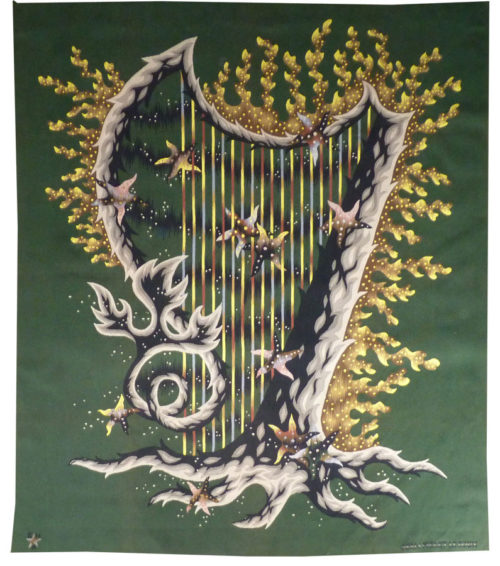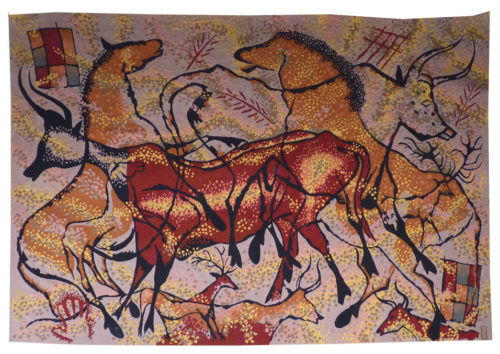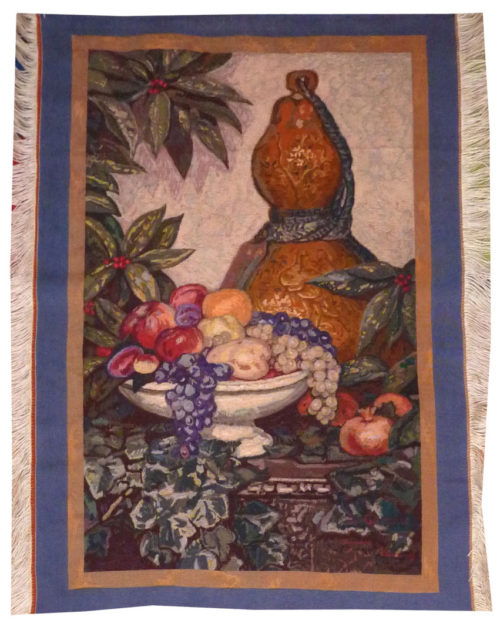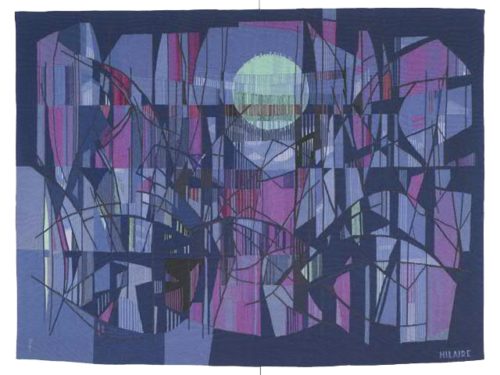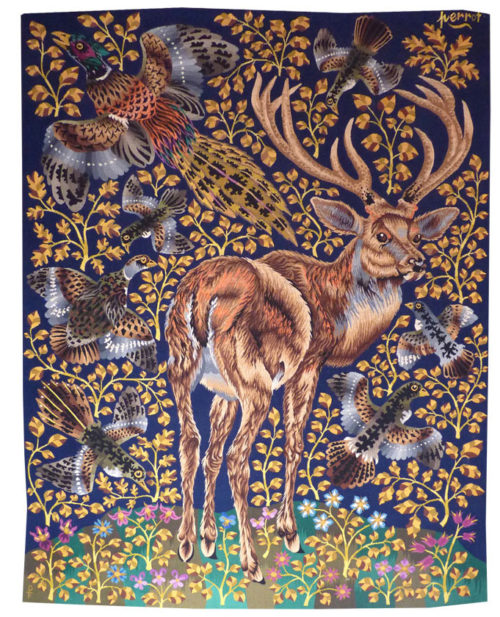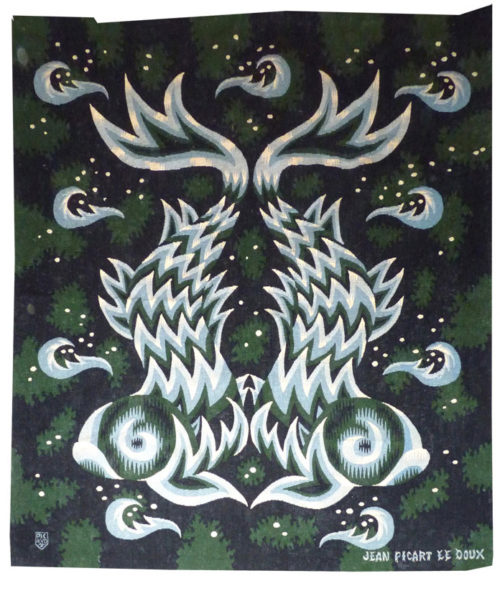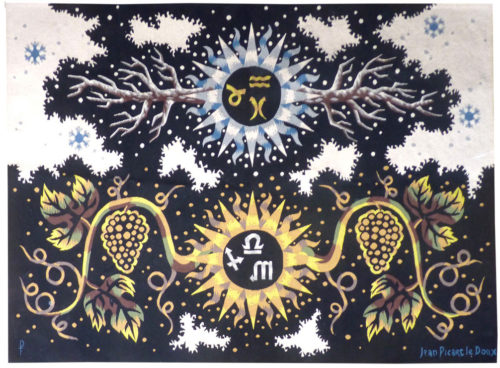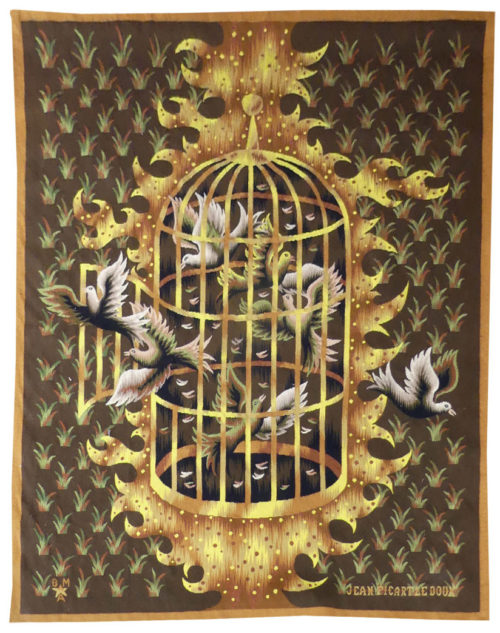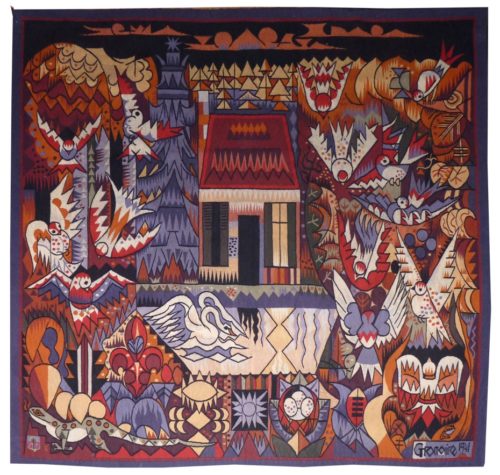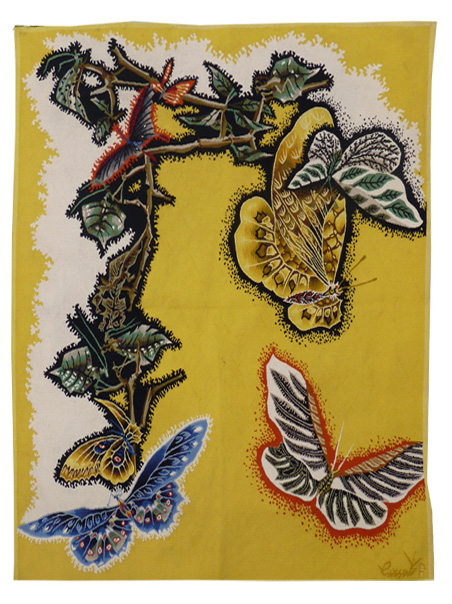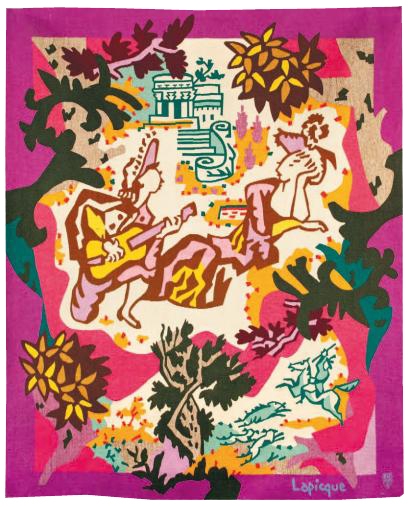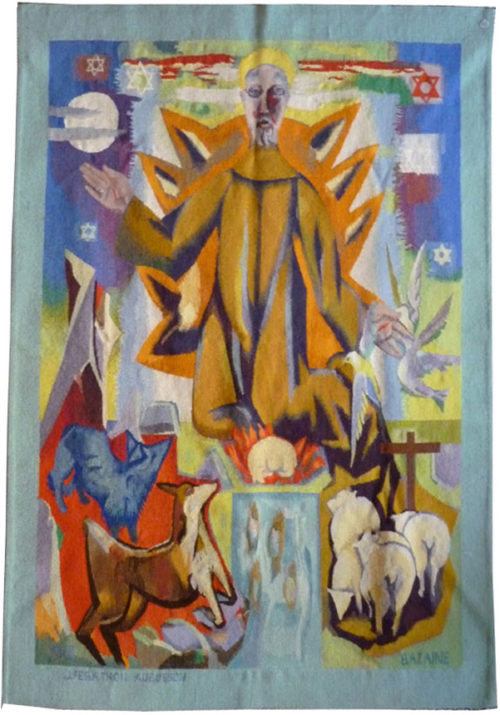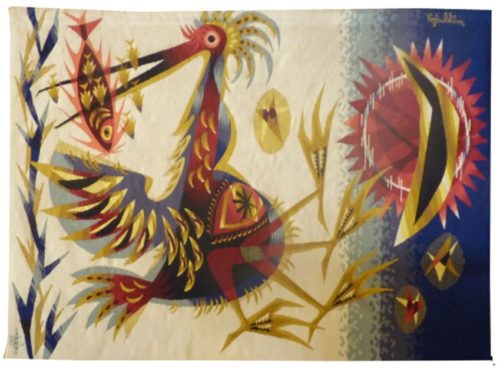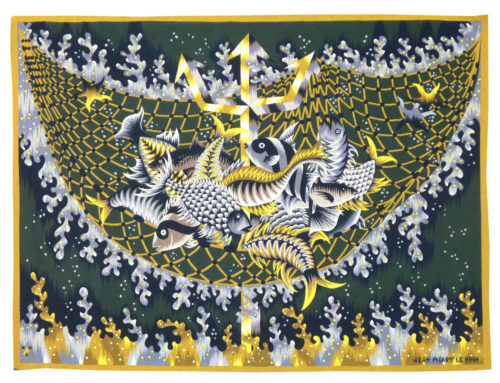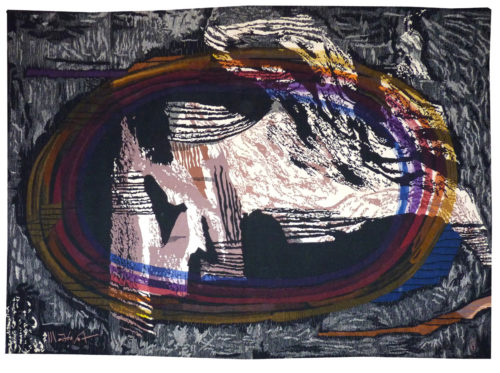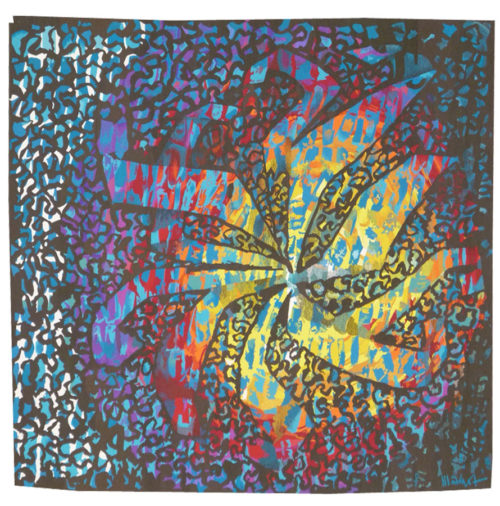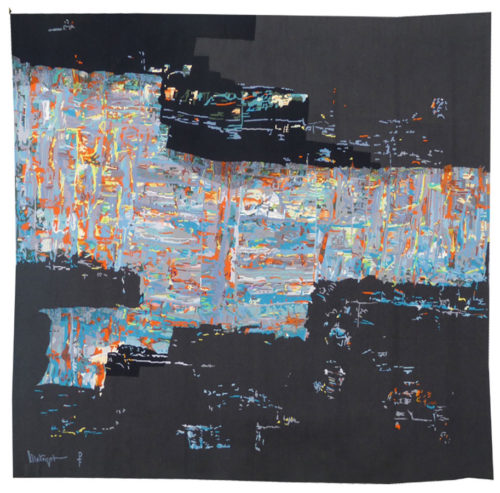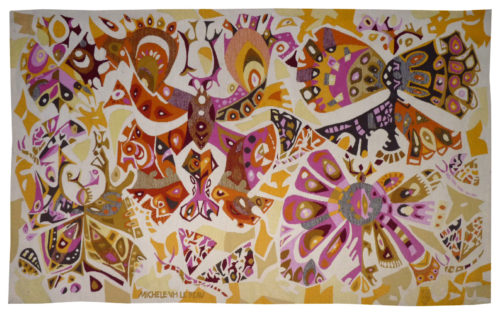-
Le réveille-matin (the alarm clock)
Tapestry woven in the Baudonnet workshop. Complete with signed label. 1959. Lurçat approached Saint-Saëns, originally a painter of murals, in 1940. And during the war the latter produced the first of his allegorical masterpieces, tapestries reflecting indignation, combat, resistance : “les Vierges folles (the foolish virgins), “Thésée et le Minotaure” (Theseus and the Minotaur). At the end of the war, as a natural development he joined up with Lurçat, whose convictions he shared (concerning a simplified palette, outlined cartoons with colours indicated by pre-ordained numbers, and the specific nature of tapestry design...) at the A.P.C.T. (Association des Peintres-cartonniers de Tapisserie). His universe, where the human figure, stretched, elongated, ooccupies an important place (particularly when compared to his companions Lurçat or Picart le Doux), pivots around traditional themes : woman, the Commedia dell’arte, Greek mythology... refined by the brilliance of the colours and the simplification of the layout. His work would evolve later, in the 1960’s, towards cartoons of a more lyrical design, almost abstract where elemental and cosmic forces would dominate. “Saint-Saens who produced a series of birds in 1949 only rarely represented the cock, a recurrent subject for Lurçat. In this piece the cock has no symbolic value but merely announces with gales of crowing and colour the arrival of the new day.” (Exhibition Catalogue Sain-Saëns, œuvre tissé, Aubusson, Musée départemental de la Tapisserie, 1987 p.48) Bibliography : Exhibition catalogue Saint-Saëns, galerie La Demeure, 1970 Exhibition catalogue Saint-Saëns, the tapestries, Aubusson, Musée départemental de la Tapisserie, 1987, ill. p.49 Exhibition catalogue Marc Saint-Saëns, tapestries, 1935-1979, Angers, Musée Jean Lurçat et de la Tapisserie Contemporaine 1997-1998 -
Ô soleil (O Sun)
Aubusson tapestry woven by the Hamot workshop. With signed label, n°2/8. 1968. Jean Picart le Doux is one of the foremost figures in the renaissance of the art of tapestry. His earliest contributions to the field date back to 1943 when he designed cartoons for the passenger ship “la Marseillaise”. A close associate of Lurçat, whose theories he would adopt (limited palette, numbered cartoons...), he was a founding member of the A.P.C.T. (Association des Peintres-cartonniers de Tapisserie), and soon after, a teacher at the Ecole Nationale Supérieure des Arts Décoratifs. The state gave him several commissions most of them at the Aubusson workshop, and some at the Gobelins : the most spectacular of these being for the University of Caen, the Theatre in Le Mans, the passenger ship France or the Prefecture of the Creuse département ... In as much as Picart le Doux’s aesthetic is close to that of Lurçat, so also is his inspiration and his subject matter, although in a register which is more decorative than symbolic, where he brings together heavenly bodies (the sun, the moon, the stars...), the elements, nature (wheat, vines, fish, birds...), man, literary quotation ... « The inclusion of text constitutes a closer means of communication with the poet” says Picart le Doux (a process used also by Lurçat) who will quote Apollinaire as here (“la jolie rousse”) but also Whitman, Eluard, Saint John Perse,... Illustrated by an ardent heart and, in a literal reflection of the text, by the sun, he associates the zodiac, one of his recurrent motifs, with the love poem. Bibliography : Maurice Bruzeau, Jean Picart le Doux, Murs de soleil, Editions Cercle d’art, 1972, ill. n°161 Exhibition Catalogue, Jean Picart le Doux, tapisseries, Musée de Saint-Denis, 1976 Exhibition Catalogue Jean Picart le Doux, Musée de la Poste, 1980 -
Dragon dans la nuit (a dragon in the night)
Aubusson tapestry woven in the Pinton workshop. Complete with certificate of origin signed by the artist, n°1/6. Circa 1965. Matégot, originally a decorator, then creator of artefacts and furniture (an activity he abandoned in 1959) met François Tabard in 1945 and gave him his first cartoons, first of all figurative then rapidly of abstract design in the 1950’s. He became a member of the A.P.C.T. (Association des Peintres Cartonniers de Tapisserie) in 1949, participated in many international exhibitions (Matégot, like Lurçat before him, was an untiring advocate of the art of tapestry) fulfilled numerous public commissions, sometimes of monumental proportions (“Rouen” 85m2 for the Préfecture of the Seine Maritime département, and also tapestries for Orly Airport, for the Maison de la Radio, for the IMF...) and designed no fewer than 629 cartoons up until the 1970’s. In 1990 the Matégot foundation for contemporary tapestry was inaugurated in Bethesda, U.S.A. Matégot is an artist, like Wogensky, Tourlière or Prassinos, who turns wool textiles resolutely towards the abstract: at first lyrical, geometric in the 70’s, exploiting various technical aspects of the loom : colour graduations, shading, irregularities... The cartoon is characterised by the habitual contrast of light and shadow, typical of those of this period ; the title, however, conveys a more figurative context, evoking a fantastic beast breathing flames (and indeed illustrated in fire) to disperse the darkness. Bibliography : Exhibition catalogue, Matégot, Angers, Musée Jean Lurçat et de la Tapisserie Contemporaine, 1990-1991 Patrick Favardin, Mathieu Matégot, Editions Norma, 2014 -
Les oiseaux s'envolent (birds fly)
Aubusson tapestry woven in the Berthaut workshop. Complete with certificate of origin signed by the artist. 1949. Jean Picart le Doux is one of the foremost figures in the renaissance of the art of tapestry. His earliest contributions to the field date back to 1943 when he designed cartoons for the passenger ship “la Marseillaise”. A close associate of Lurçat, whose theories he would adopt (limited palette, numbered cartoons…), he was a founding member of the A.P.C.T. (Association des Peintres-cartonniers de Tapisserie), and soon after, a teacher at the Ecole Nationale Supérieure des Arts Décoratifs. The state gave him several commissions most of them at the Aubusson workshop, and some at the Gobelins : the most spectacular of these being for the University of Caen, the Theatre in Le Mans, the passenger ship France or the Prefecture of the Creuse département … In as much as Picart le Doux’s aesthetic is close to that of Lurçat, so also is his inspiration and his subject matter, although in a register which is more decorative than symbolic, where he brings together heavenly bodies (the sun, the moon, the stars…), the elements, nature (wheat, vines, fish, birds…), man, literary quotation … “Les oiseaux s’envolent” (the flight of the birds) was intended as a symbolic representation of the Liberation of France, a theme which recurrs in the “la cage ouverte’ (the open cage) in 1953. Bibliography : Maurice Bruzeau, Jean Picart le Doux, Murs de soleil, Editions Cercle d’art, 1972, n°13 Exhibition Catalogue, Jean Picart le Doux, tapisseries, Musée de Saint-Denis, 1976 Exhibition Catalogue Jean Picart le Doux, Musée de la Poste, 1980 -
Le luth et les colombes (the lute and the doves)
Aubusson tapestry woven in the Berthaut workshop. Complete with certificate of origin signed by the artist, n°6/8. Circa 1955. Jean Picart le Doux is one of the foremost figures in the renaissance of the art of tapestry. His earliest contributions to the field date back to 1943 when he designed cartoons for the passenger ship “la Marseillaise”. A close associate of Lurçat, whose theories he would adopt (limited palette, numbered cartoons...), he was a founding member of the A.P.C.T. (Association des Peintres-cartonniers de Tapisserie), and soon after, a teacher at the Ecole Nationale Supérieure des Arts Décoratifs. The state gave him several commissions most of them at the Aubusson workshop, and some at the Gobelins : the most spectacular of these being for the University of Caen, the Theatre in Le Mans, the passenger ship France or the Prefecture of the Creuse département ... In as much as Picart le Doux’s aesthetic is close to that of Lurçat, so also is his inspiration and his subject matter, although in a register which is more decorative than symbolic, where he brings together heavenly bodies (the sun, the moon, the stars...), the elements, nature (wheat, vines, fish, birds...), man, literary quotation ... The lute and the doves is a reworking of a larger and more densely decorated cartoon dating from 1949 and titled “les oiseaux s’envolent” (the flight of the birds) which was intended as a symbolic representation of the Liberation of France, a theme which recurrs in the “la cage ouverte’ (the open cage) in 1953. Bibliography : Marthe Belle-Jouffray, Jean Picart le Doux, Publications filmées d’art et d’histoire, 1966, ill. n°3 Maurice Bruzeau, Jean Picart le Doux, Murs de soleil, Editions Cercle d’art, 1972 Exhibition Catalogue, Jean Picart le Doux, tapisseries, Musée de Saint-Denis, 1976 Exhibition Catalogue Jean Picart le Doux, Musée de la Poste, 1980 -
Vega
Aubusson tapestry woven in the Legoueix workshop. Certificate of origin signed by the artist n° 2 of 4. 1967. A member of the A.P.C.T. (Association des Peintres-Cartonniers de Tapisserie), Wogensky is one of the many artists who would follow in Lurçat’s footsteps immediately after the war. At first influenced by his predecessor, Wogensky’s subsequent work (159 cartoons according to the 1989 exhibition catalogue) would evolve during the 1960’s towards a, not completely self-avowed, lyrical abstraction, from cosmic-astronomical themes expressed in decomposed, moving, birdlike shapes to cartoons both more refined and less dense. Although always claiming to be a painter, the artist’s conception of tapestry is extremely well thought out : “the realisation of a mural cartoon.... requires the consideration of a space which is no longer ours alone, by the nature of its dimensions, its scale, it also imposes a grand gesture which transforms and accentuates our presence.” « Vega » is a work inspired by Wogensky’s « cosmic » vein (it’s title alone bears witness to the fact) which lasted through the 1960’s and of which “Cosmos” (1968 Strasbourg University) and “Galaxy” (1970, Sénat Palais du Luxembourg) would be the high points. Shading (omnipresent) and blocks of colour co-exist in a subtle harmony, evoking a curious, unknown world with elements of the infinitely small as seen through a microscope and the infinitely large. Bibliography : Exhibition catalogue Robert Wogensky, Aubusson, Musée départemental de la tapisserie, 1989 Exhibition catalogue Robert Wogensky, Angers, Musée Jean Lurçat et de la Tapisserie Contemporaine, 1989 -
Concert des oiseaux (concert of birds)
Tapestry woven in the Picaud workshop. Complete with certificate of origin signed by the artist, n°4/6. Circa 1975. Jean Picart le Doux is one of the foremost figures in the renaissance of the art of tapestry. His earliest contributions to the field date back to 1943 when he designed cartoons for the passenger ship “la Marseillaise”. A close associate of Lurçat, whose theories he would adopt (limited palette, numbered cartoons...), he was a founding member of the A.P.C.T. (Association des Peintres-cartonniers de Tapisserie), and soon after, a teacher at the Ecole Nationale Supérieure des Arts Décoratifs. The state gave him several commissions most of them at the Aubusson workshop, and some at the Gobelins : the most spectacular of these being for the University of Caen, the Theatre in Le Mans, the passenger ship France or the Prefecture of the Creuse département ... In as much as Picart le Doux’s aesthetic is close to that of Lurçat, so also is his inspiration and his subject matter, although in a register which is more decorative than symbolic, where he brings together heavenly bodies (the sun, the moon, the stars...), the elements, nature (wheat, vines, fish, birds...), man, literary quotation ... Music as a theme is frequently associated with birds in Picart le Doux’s work ; this particular cartoon is an extension of the « harpe des forêts” tapestry dating from 1953. Bibliography : Maurice Bruzeau, Jean Picart le Doux, Murs de soleil, Editions Cercle d’art, 1972 Exhibition Catalogue, Jean Picart le Doux, tapisseries, Musée de Saint-Denis, 1976 Exhibition Catalogue Jean Picart le Doux, Musée de la Poste, 1980 -
le tiercelet (the sparrow hawk)
Aubusson tapestry woven by the Legoueix workshop. Complete with certificate of origin signed by the artist's beneficiary, n° E.A.1 1942. Elie Maingonnat governed the Ecole Nationale des Arts Décoratifs d’Aubusson from 1930 until 1958 where he took over from Marium Martin (who already recommended the use of a limited number of colours and the use of hachures, a similar technique to hatching) of whom he was a pupil. As well as assuming the responsibilities of his position, Maingonnat devoted himself to designing cartoons : motifs of dense vegetation animated by the presence of a few animals, both of which were inspired by the flora and fauna of the Limousin area of France revitalising the traditional theme of greenery used in the XVIIth and XVIIIth centuries. This cartoon is typical of Maingonnat’s work : local flora and fauna (here a diminutive sparrow hawk among gentians on the bank of a mountain stream) are illustrated in a limited grey-green spectrum which is reflected and emphasised by the browns of the stones in the river. Bibliographie : Exhibition Catalogue Elie Maingonnat, Aubusson, Musée départemental de la tapisserie, 1986-1987, Ill. -
Etoiles de neige (Snow Flakes)
Aubusson tapestry woven in the Berthaut workshop. N°7/8. 1962. Jean Picart le Doux is one of the foremost figures in the renaissance of the art of tapestry. His earliest contributions to the field date back to 1943 when he designed cartoons for the passenger ship “la Marseillaise”. A close associate of Lurçat, whose theories he would adopt (limited palette, numbered cartoons...), he was a founding member of the A.P.C.T. (Association des Peintres-cartonniers de Tapisserie), and soon after, a teacher at the Ecole Nationale Supérieure des Arts Décoratifs. The state gave him several commissions most of them at the Aubusson workshop, and some at the Gobelins : the most spectacular of these being for the University of Caen, the Theatre in Le Mans, the passenger ship France or the Prefecture of the Creuse département ... In as much as Picart le Doux’s aesthetic is close to that of Lurçat, so also is his inspiration and his subject matter, although in a register which is more decorative than symbolic, where he brings together heavenly bodies (the sun, the moon, the stars...), the elements, nature (wheat, vines, fish, birds...), man, literary quotation ... The theme of winter is chracterised in Picart le Doux’s work by the use of templates, colours (muted tones, browns, black, white), and motifs (bare branches, kaleidoscopic flake shapes) ; the snow flakes referred to here will also be used in “Solstice d’hiver” and “Hommage à Vivaldi”. Bibliography : Maurice Bruzeau, Jean Picart le Doux, Murs de soleil, Editions Cercle d’art, 1972, ill. n°122 Exhibition Catalogue, Jean Picart le Doux, tapisseries, Musée de Saint-Denis, 1976 Exhibition Catalogue Jean Picart le Doux, Musée de la Poste, 1980 -
Le phénix (the phoenix)
Aubusson tapestry woven in the Hamot workshop. Complete with label signed by the artist, n°EA. 1965. Jean Picart le Doux is one of the foremost figures in the renaissance of the art of tapestry. His earliest contributions to the field date back to 1943 when he designed cartoons for the passenger ship “la Marseillaise”. A close associate of Lurçat, whose theories he would adopt (limited palette, numbered cartoons...), he was a founding member of the A.P.C.T. (Association des Peintres-cartonniers de Tapisserie), and soon after, a teacher at the Ecole Nationale Supérieure des Arts Décoratifs. The state gave him several commissions most of them at the Aubusson workshop, and some at the Gobelins : the most spectacular of these being for the University of Caen, the Theatre in Le Mans, the passenger ship France or the Prefecture of the Creuse département ... In as much as Picart le Doux’s aesthetic is close to that of Lurçat, so also is his inspiration and his subject matter, although in a register which is more decorative than symbolic, where he brings together heavenly bodies (the sun, the moon, the stars...), the elements, nature (wheat, vines, fish, birds...), man, literary quotation ... « Le Phénix » (The Phoenix) (An identical lithograph exists also), a subject inspired by legend (a rare event in the work of Picard le Doux) reproduces a chromatic harmony of yellow motifs against a red background typical of this particular artist. Bibliography : Maurice Bruzeau, Jean Picart le Doux, Murs de soleil, Editions Cercle d’art, 1972, ill. n°162 Exhibition Catalogue, Jean Picart le Doux, tapisseries, Musée de Saint-Denis, 1976 Exhibition Catalogue Jean Picart le Doux, Musée de la Poste, 1980 -
Poissons et grenouilles (fish and frogs)
Aubusson tapestry woven by the Picaud workshop. Complete with signed label, n°1/4. Circa 1970. Elie Grekoff, whose aesthetic is similar to that of Lurçat, designed over 300 cartons : a black background evokes an underwater world where fish and leaves are pictured with the amusing and un-Lurçat-like presence of frogs. -
Soleils éteints (Extinct suns)
Aubusson tapestry woven in the Pinton workshop. Complete with certificate of origin signed by the artist, n°1/6. Circa 1970. Originally an engraver (Prix de Rome, intaglio technique in 1942), Jean-Louis Viard designed his first tapestry cartoons in the mid 1950’s. At first his work was figurative (he was collaborating at the time with Picart Le Doux), but then he evolved along the same lines as many other painter-cartoonists of the period (Matégot, Tourlière or Prassinos,...) towards abstraction. He produced scores of cartoons working up until the 2000’s, in parallel to his work as a painter and engraver, but throughout revealing a particular interest for the use of contrasting materials and textures in the tradition of the “Nouvelle Tapisserie” of which Pierre Daquin was one of the leading lights. The inspiration for his motifs, sometimes metaphysical (“Mémoires” Memories, “Destins” Destinies,…) is wide-reaching, from astronomical infinity « ténèbres solaires » solar darkness) to the microscopic (« Mutation végétale” Plant mutation) : a profuse and varied production, regularly exhibited at his home, in various public and private exhibition spaces and, most significantly, at the Salon Comparaison of which he was the curator for the Tapestry section. Origin : the artist’s workshop -
Destins (Destinies)
Aubusson tapestry woven in the Glaudin-Brivet workshop. Complete with certificate of origin signed by the artist, n°1/6. 1974. Originally an engraver (Prix de Rome, intaglio technique in 1942), Jean-Louis Viard designed his first tapestry cartoons in the mid 1950’s. At first his work was figurative (he was collaborating at the time with Picart Le Doux), but then he evolved along the same lines as many other painter-cartoonists of the period (Matégot, Tourlière or Prassinos,...) towards abstraction. He produced scores of cartoons working up until the 2000’s, in parallel to his work as a painter and engraver, but throughout revealing a particular interest for the use of contrasting materials and textures in the tradition of the “Nouvelle Tapisserie” of which Pierre Daquin was one of the leading lights. The inspiration for his motifs, sometimes metaphysical (“Mémoires” Memories, “Destins” Destinies,…) is wide-reaching, from astronomical infinity « ténèbres solaires » solar darkness) to the microscopic (« Mutation végétale” Plant mutation) : a profuse and varied production, regularly exhibited at his home, in various public and private exhibition spaces and, most significantly, at the Salon Comparaison of which he was the curator for the Tapestry section. Origin : the artist’s workshop -
Fleur de roc (rock flower)
Aubusson tapestry woven in the Legoueix workshop. n°2/4. Circa 1970. Originally a sculptor exploiting very diverse materials (steel, concrete, clay…), Borderie came to tapestry with immense enthusiasm in the 1950’s with the weaving of his first cartoon in 1957. Receiving encouragement from Denise Majorel, he was awarded the Grand Prix National de la Tapisserie in 1962. In 1974 he was appointed as director at the Ecole Nationale des Arts Décoratifs at Aubusson but he resigned from this post shortly thereafter. He designed over 500 painted cartoons, abstracts using simple shapes, shading in a limited palette of colours and weaving with gros points. A dynamic abstraction with a limited colour scheme running from orange to brown, abstract motifs which play on the plastic effect of light passing through the colours : a classic cartoon from André Borderie. Bibliography : Exhibition catalogue André Borderie « pour l’homme simplement », Angers, Musée Jean Lurçat et de la Tapisserie Contemporaine 1998. J.J. et B. Wattel, André Borderie et la tapisserie d'Aubusson, Editions Louvre Victoire, 2018, ill. p.22 -
L'éveil (the awakening)
Aubusson tapestry woven in the Legoueix workshop. n°4/6. 1969. It was in 1953 that Jean Picart le Doux proposed to Chaye to become his assistant and encouraged him to design tapestry cartoons : he would produce numerous bucolic cartoons, but also views of Normandy (Mont Saint Michel, Honfleur, regattas,...) whence he came. Here birds and trelliswork cohabit in a style very reminiscent of Picart le Doux. Bibliography : Simon Chaye tapisseries contemporaines, Editions Librairie des musées, 2014, ill. p.30 -
Ichtyonis
Tapestry woven in the Raymond workshop. Complete with certificate of origin signed by the artist, n°EA1. Circa 1980. Originally an engraver (Prix de Rome, intaglio technique in 1942), Jean-Louis Viard designed his first tapestry cartoons in the mid 1950’s. At first his work was figurative (he was collaborating at the time with Picart Le Doux), but then he evolved along the same lines as many other painter-cartoonists of the period (Matégot, Tourlière or Prassinos,...) towards abstraction. He produced scores of cartoons working up until the 2000’s, in parallel to his work as a painter and engraver, but throughout revealing a particular interest for the use of contrasting materials and textures in the tradition of the “Nouvelle Tapisserie” of which Pierre Daquin was one of the leading lights. The inspiration for his motifs, sometimes metaphysical (“Mémoires” Memories, “Destins” Destinies,…) is wide-reaching, from astronomical infinity « ténèbres solaires » solar darkness) to the microscopic (« Mutation végétale” Plant mutation) : a profuse and varied production, regularly exhibited at his home, in various public and private exhibition spaces and, most significantly, at the Salon Comparaison of which he was the curator for the Tapestry section. Origin : the artist’s workshop -
Danseuses cambodgiennes (Cambodian dancers)
Tapestry woven at Aubusson by the Picaud workshop. Certificate of origin, n° 1/4. Circa 1965. Although somewhat overlooked now, the contribution that Maurice Ferréol made, in the 1960’s, to the design of figurative tapestry is quite remarkable. He proposed a style redolent of popular imagery where the use of pure blocks of colour exacerbates the almost childlike outline of the figures. What connects these bright and garishly coloured, masked figures to Cambodia? They are simply a pretext for a profusion of colours and motifs in the particular characteristic style of Ferréol. -
La roue (the wheel)
Aubusson tapestry woven by the Pinton workshop. Complete with certificate of origin. Circa 1970. Perrot began his career as a cartoon designer at the end of the war, making almost 500 cartoons including numerous commissions from the state, most of which were woven at Aubusson. His style which is particularly rich and decorative is eminently recognisable : a crowd of butterflies or birds, most often, stands out against a background of vegetation, reminiscent of the millefleurs tapestries (which would also inspire Dom Robert). The mediaeval inspiration of a flower-studded, khaki background, numerous birds, all the characteristic elements of Perrot’s cartoons can be found in this particular example. Bibliography: Tapisseries, dessins, peintures, gravures de René Perrot, Dessein et Tolra, 1982 -
Galathée
Aubusson tapestry woven by the Picaud workshop. Complete with certificate of origin signed by the artist, n° 1 of 4. 1970. Loewer designed his first cartoon in 1953 ; his early works are first figurative before turning to abstraction (like Matégot) which is exclusively geometric in Loewer’s case. He designed over 180 cartoons, most of which were woven by his friend, Raymond Picaud. Only one example of this tapestry was woven according to the catalogue raisonné, « Galathée » is representative of the artist’s style around 1970 where the recurrent design motif is the square used in superpositions. Bibliography : Claude Loewer, l’évasion calculée : travaux de 1939 à 1993, catalogue raisonné des tapisseries de 1953 à 1974, Sylvio Acatos, Charlotte Hug, Walter Tschopp and Marc-Olivier Wahler, Artcatos, 1994, n°120 -
Soleil carré (square sun)
Aubusson tapestry woven in the Pinton workshop. Complete with certificate of origin signed by the artist, n°EX-A. Circa 1965. Matégot, originally a decorator, then creator of artefacts and furniture (an activity he abandoned in 1959) met François Tabard in 1945 and gave him his first cartoons, first of all figurative then rapidly of abstract design in the 1950’s. He became a member of the A.P.C.T. (Association des Peintres Cartonniers de Tapisserie) in 1949, participated in many international exhibitions (Matégot, like Lurçat before him, was an untiring advocate of the art of tapestry) fulfilled numerous public commissions, sometimes of monumental proportions (“Rouen” 85m2 for the Préfecture of the Seine Maritime département, and also tapestries for Orly Airport, for the Maison de la Radio, for the IMF...) and designed no fewer than 629 cartoons up until the 1970’s. In 1990 the Matégot foundation for contemporary tapestry was inaugurated in Bethesda, U.S.A. Matégot is an artist, like Wogensky, Tourlière or Prassinos, who turns wool textiles resolutely towards the abstract: at first lyrical, geometric in the 70’s, exploiting various technical aspects of the loom : colour graduations, shading, irregularities... « Soleil carré » (Square sun - a contradiction in terms) also illustrates Matégot’s style in the mid-60’s, where shadow and light are in open confrontation : from the upper right hand part of the tapestry the colours radiate outwards dispersing the darkness in concentric fashion. Bibliography : Exhibition catalogue, Matégot, Angers, Musée Jean Lurçat et de la Tapisserie Contemporaine, 1990-1991 Patrick Favardin, Mathieu Matégot, Editions Norma, 2014 -
Normands sur la Seine (Norsemen on the Seine)
Tapestry woven at Aubusson by the Pinton workshop. Signed certificate of origin n° 1. 1961. Lars Gynning is one of the numerous artists of various origins whose work would be woven in Aubusson during the years from the 50’s to the 70’s, at a period when tapestry imposed itself as an artistic medium. From a thematic point of view, this cartoon can be seen as a referrence, across the centuries, to Franco-Scandinavian relations seen through the prism of Viking incursions up the Seine estuary : an inevitable throw-back to the Bayeux tapestry. However, rather than a historic or diplomatic statement by Gynning, the cartoon in fact illustrates a saga by Evart Taube, the 20th century Swedish national poet (an extract from the text is woven at the bottom of the tapestry) ; added to the subject itself, the textile rendition of an epic saga is a gesture in the direction of the great mediaeval tapestry tradition, which was an inevitable model for many painter-cartoonists of the period. The aesthetic, which is resolutely contemporary and influenced by cubism, revitalises an ancient subject. -
Poissons de la lune (Moon fish)
Aubusson tapestry woven by the Pinton workshop. Complete with certificate of origin. Circa 1960. Fumeron designed his first cartoons (he would ultimately make over 500) in the 1940’s, in collaboration with the Pinton workshop, he was then commissioned on numerous occasions by the state before participating in the decoration of the ocean liner “France”. His work was figurative to begin with and influenced by Lurçat, then turned towards abstraction, before coming back to a style characterised by colourful figurative and realistic depictions from the 1980’s onwards. Beneath the red moon, fish, butterflies, a lobster all frolic in a dream-like composition typical of the artist : numerous examples of these motifs can be found for instance in “Avant l’homme” Before man, woven by the Gobelins (cf Exhibition Catalogue “le Mobilier National et les Manufactures Nationales des Gobelins et de Beauvais sous la IVe République”, Beauvais 1997) -
La flamme (the flame)
Portalegre tapestry woven by the Fino workshop. Complete with certificate of origin signed by the artist, n°2/6. Circa 1965. Matégot, originally a decorator, then creator of artefacts and furniture (an activity he abandoned in 1959) met François Tabard in 1945 and gave him his first cartoons, first of all figurative then rapidly of abstract design in the 1950’s. He became a member of the A.P.C.T. (Association des Peintres Cartonniers de Tapisserie) in 1949, participated in many international exhibitions (Matégot, like Lurçat before him, was an untiring advocate of the art of tapestry) fulfilled numerous public commissions, sometimes of monumental proportions (“Rouen” 85m2 for the Préfecture of the Seine Maritime département, and also tapestries for Orly Airport, for the Maison de la Radio, for the IMF...) and designed no fewer than 629 cartoons up until the 1970’s. In 1990 the Matégot foundation for contemporary tapestry was inaugurated in Bethesda, U.S.A. Matégot is an artist, like Wogensky, Tourlière or Prassinos, who turns wool textiles resolutely towards the abstract: at first lyrical, geometric in the 70’s, exploiting various technical aspects of the loom : colour graduations, shading, irregularities... An abstract cartoon characteristic of the artist’s production in the mid-1960’s : the evocation of the flame, stylised and in an agressive violet hue, refers directly to Matégot’s interest in industry and all things technical but also to the interplay of woven transparencies of which he made himself a master. Bibliography : Exhibition catalogue, Matégot, Angers, Musée Jean Lurçat et de la Tapisserie Contemporaine, 1990-1991 -
Les comédiens (The actors)
Aubusson tapestry woven in the Legoueix workshop. N°4/6. 1959. Lurçat approached Saint-Saëns, originally a painter of murals, in 1940. And during the war the latter produced the first of his allegorical masterpieces, tapestries reflecting indignation, combat, resistance : “les Vierges folles (the foolish virgins), “Thésée et le Minotaure” (Theseus and the Minotaur). At the end of the war, as a natural development he joined up with Lurçat, whose convictions he shared (concerning a simplified palette, outlined cartoons with colours indicated by pre-ordained numbers, and the specific nature of tapestry design...) at the A.P.C.T. (Association des Peintres-cartonniers de Tapisserie). His universe, where the human figure, stretched, elongated, ooccupies an important place (particularly when compared to his companions Lurçat or Picart le Doux), pivots around traditional themes : woman, the Commedia dell’arte, Greek mythology... refined by the brilliance of the colours and the simplification of the layout. His work would evolve later, in the 1960’s, towards cartoons of a more lyrical design, almost abstract where elemental and cosmic forces would dominate. Themes of music, drama and more specifically the Commedia dell’Arte (« la Comédie Italienne », a cartoon dating from 1947) are omnipresent in Saint-Saëns’s production : here he presents the figures of Lelio and Isabelle, strikingly drawn, slightly humorous figures, presented here in their traditional costumes. Bibliography : Exhibition catalogue Saint-Saëns, galerie La Demeure, 1970 Exhibition catalogue Saint-Saëns, the tapestries, Aubusson, Musée départemental de la Tapisserie, 1987 Exhibition catalogue Marc Saint-Saëns, tapestries, 1935-1979, Angers, Musée Jean Lurçat et de la Tapisserie Contemporaine 1997-1998 -
La harpe des mers (Harp of the ocean)
Tapestry woven in the Berthaut workshop. Complete with certificate of origin signed by the artist. 1954. Jean Picart le Doux is one of the foremost figures in the renaissance of the art of tapestry. His earliest contributions to the field date back to 1943 when he designed cartoons for the passenger ship “la Marseillaise”. A close associate of Lurçat, whose theories he would adopt (limited palette, numbered cartoons...), he was a founding member of the A.P.C.T. (Association des Peintres-cartonniers de Tapisserie), and soon after, a teacher at the Ecole Nationale Supérieure des Arts Décoratifs. The state gave him several commissions most of them at the Aubusson workshop, and some at the Gobelins : the most spectacular of these being for the University of Caen, the Theatre in Le Mans, the passenger ship France or the Prefecture of the Creuse département ... In as much as Picart le Doux’s aesthetic is close to that of Lurçat, so also is his insipiration and his subject matter, although in a register which is more decorative than symbolic, where he brings together heavenly bodies (the sun, the moon, the stars...), the elements, nature (wheat, vines, fish, birds...), man, literary quotation ... « La harpe des mers » (Harp of the ocean) (Bruzeau n° 60) just as its companion piece « La harpe des forêts” (Harp of the forest), identical in size, is one of a set of cartoons by Picart le Doux dealing with the theme of the lyre and the harp : the geometrical rigour and graphic power of the parallel strings were a particular inspiration to the artist. Here, music and nature are closely associated (cf “l’arbre-lyre” the tree lyre from 1953) and Orphée Orpheus (a cartoon from 1952) is the single figure which encapsulates this assimilation. Bibliography : Maurice Bruzeau, Jean Picart le Doux, Murs de soleil, Editions Cercle d’art, 1972 Exhibition catalogue Jean Picart le Doux, Musée de la Poste, 1980 -
Hommage à l'abbé Breuil (a tribute to Father Breuil)
Aubusson tapestry woven by the Pinton workshop. Complete with certificate of origin. Circa 1955. Perrot began his career as a cartoon designer at the end of the war, making almost 500 cartoons including numerous commissions from the state, most of which were woven at Aubusson. His style which is particularly rich and decorative is eminently recognisable : a crowd of butterflies or birds, most often, stands out against a background of vegetation, reminiscent of the millefleurs tapestries (which would also inspire Dom Robert). Uncharacteristic cartoon whose inspiration lies in the cave paintings at Lascaux ; here it can be said that never has a tapestry merited quite so well the term « wall art ». Perrot’s input is, in the end, relatively modest : the use of saturated colours (particularly the mauve-pink background), the overlapping of the motifs (which are more spaced out in the cave itself), superficial laid over blotching,... If Perrot is an habitué of hommage-cartoons (Pergaud, Redouté, Audubon,...) this particular example is interesting because of the well-established proximity between the artist and the dedicatee, “the Pope of Prehistory”: here the hommage owes nothing to the artificiality of an official commission. Bibliography : Tapisseries, dessins, peintures, gravures de René Perrot, Dessein et Tolra, 1982 -
Nature morte (still life)
Gobelins tapestry woven by G. Bonnevialle. Complete with label. 1930-1931 (after a 1921 painting). An establishment artist of classical training, Migonney spent many long years in Algeria, which would furnish the subject of much of his work. He gave several cartoons to the Ecole Nationale d’Art Décoratif in Aubusson (along with Véra, Valtat...), whose exhibition stand at the Exposition Internationale des Arts Décoratifs in 1925 included a panel bearing one of his tapestries. This piece is a detail, woven after the artist’s death, taken from a spectacular work (137x205cm) dating from 1921 which hangs in the Musée de Brou in Bourg en Bresse, “Still life with fruit”. It reveals all the weaving detail and nuances which constituted the art of the Gobelin weavers when reproducing a painting, techniques whose use Lurcat would soon make a point of opposing. Bibliography : Exhibition Cat. Tapisseries 1925, Aubusson, Cité de la Tapisserie, 2012 -
Nymphes et chasseurs (Nymphs and hunters)
Aubusson tapestry woven in the Pinton workshop for the Compagnie des Arts Français. 1941. The place occupied by André Planson in the history of tapestry-making is a direct result of the role that was alotted to him by Jacques Adnet in the synthesis of art and design advocated by the Compagnie des Arts Français of which he was the director. As early as 1941, Adnet approached several painters (Brianchon, Vera,... and Planson) to design tapestry cartoons in the context of furniture and interior design : “our intention was to demonstrate that contemporary tapestries have much to contribute to the integrated design of a room” (L. Chéronnet, Jacques Adnet, Art et Industrie 1948). The Compagnie des Arts Français organised throughout the 1940’s tapestry exhibitions on its premises. These ambitious decorative aspirations, which were important in encouraging the renewal of the art of the tapestry, remain however somewhat irrelevant to the preoccupations of Lurçat and his followers. The gracious and joyful attributes (compare with the contemporary creations of Lurçat or Gromaire) of the Compagnie are plainly evident in this cartoon dating from 1941 which brings right up to date the traditional tapestry themes of the hunting scene and bucolic pleasures in a voluntarily innovative style which is highly decorative. Although certain technical innovations typical of the Lurçat doctrine are already assimilated (limited palette, irregular stitch size) it is to be noted that this decorative intention is still influenced by techniques associated with painting (the use of perspective, and shading for flesh colours...) -
Camargue
Aubusson tapestry woven in the Pinton workshop. Complete with certificate of origin signed by the artist n° 4 of 6. 1963. With a taste for the large-scale, influenced by Untersteller at the Ecole des Beaux Arts, Hilaire undertook numerous mural paintings. In the same vein, beginning in 1949, along with a number of other artists stimulated by Lurçat, (he would join the latter at the A.P.C.T. Association des Peintres-Cartonniers de Tapisserie) he designed a number of cartoons some of which were woven at Beauvais or at Les Gobelins. His figurative cubist-influenced style (which sometimes approaches abstraction) is immediately recognisable in his tapestry cartoons : in this one, but also for example in the one designed for the Salon Fontainebleau for the ocean liner France, “Sous-bois” (undergrowth) (190 x 988 cm, Pinton frères, reproduced in Le paquebot France, Armelle Bouchet Mazas, Paris 2006p. 169) where shapes and colours are fragmented in a kaleidoscopic fashion. “Camargue” is reproduced in the “Tapisserie d’Aubusson” sample collection of the Guéret Chamber of Commerce and Industry published in the early 1980’s to illstrate the technical competence of the Aubusson workshops. Bibliography : Exhibition catalogue Hilaire, œuvre tissé, galerie Verrière, 1970 (ill.) Exhibition catalogue, du trait à la lumière, Musée Départemental Georges de la Tour at Vic-sur-Seille, 2010. -
Rambouillet
Aubusson tapestry woven in the Pinton workshop. Complete with certificate of origin signed by the artist, n° 1 of 6. Circa 1970. Perrot began his career as a cartoon designer at the end of the war, making almost 500 cartoons including numerous commissions from the state, most of which were woven at Aubusson. His style which is particularly rich and decorative is eminently recognisable : a crowd of butterflies or birds, most often, stands out against a background of vegetation, reminiscent of the millefleurs tapestries (which would also inspire Dom Robert). René Perrot is essentially an animal artist who habitually uses stylisation. His decorative style is counterweighted here by the extreme realism with which the stag is represented, rare in post-war tapestry. The title of the cartoon is a throw-back to the grand French hunting tradition which he abundantly illustrated, for example in “Sologne”, which was donated to the Musée de la Chasse in Gien by the Mobilier National. -
Les Dauphins (Dolphins)
Aubusson tapestry woven in the Picaud workshop. Complete with certificate of origin signed by the artist, n° 6 of 8. 1959. Jean Picart le Doux is one of the foremost figures in the renaissance of the art of tapestry. His earliest contributions to the field date back to 1943 when he designed cartoons for the passenger ship “la Marseillaise”. A close associate of Lurçat, whose theories he would adopt (limited palette, numbered cartoons...), he was a founding member of the A.P.C.T. (Association des Peintres-cartonniers de Tapisserie), and soon after, a teacher at the Ecole Nationale Supérieure des Arts Décoratifs. The state gave him several commissions most of them at the Aubusson workshop, and some at the Gobelins : the most spectacular of these being for the University of Caen, the Theatre in Le Mans, the passenger ship France or the Prefecture of the Creuse département ... In as much as Picart le Doux’s aesthetic is close to that of Lurçat, so also is his insipiration and his subject matter, although in a register which is more decorative than symbolic, where he brings together heavenly bodies (the sun, the moon, the stars...), the elements, nature (wheat, vines, fish, birds...), man, literary quotation ... Reproduced as n° 95 in Bruzeau, the latter comments : « Perfect symbolism of a theme already treat ed ». It is true that, from the very beginning, Picart le Doux made recurrent use of the theme of the sea, and particularly with “le Dauphin” (the Dolphin) in 1951 (Bruzeau n° 27). This cartoon, though rather more stylised, is typical of the symetry favoured by the artist and is executed in a colour scheme redolent of the sea bed. Bibliography : Maurice Bruzeau, Jean Picart le Doux, Murs de soleil, Editions Cercle d’art, 1972 -
Combat devant Florence (Combat before Florence)
Aubusson tapestry woven by the Goubely-Gatien workshop. With partially erased certificate of origin. 1966. An enthusiastic mural artist as early as 1937 (he participated in the Exposition Internationale), Lagrange designed his first cartoons in 1945, and became one of the founding members of the A.P.C.T. His early cartoons were expressionist (like Matégot and Tourlière), then his work evolved towards a stylisation (dating from his collaboration with Pierre Baudouin) which would bring him in the 1970’s to a highly refined style using very pure colours. As well as his important rôle in the tapestry renaissance movement of the period (and the state commissions that went with it), Lagrange would become a teacher at the Ecole Nationale des Beaux-Arts, a regular collaborator with Jacques Tati, a designer of monumental elements incorporated in various architectural projects and a recognised painter close to Estève and Lapicque. In the 1960’s, the artist made various large-scale works based on the mediaeval theme of battles and tournaments, in a geometrical and stylised vision, of which the most noted example is the “Hommage to Paulo Uccello” (280 x 680 cm, of which a copy is kept at the Faculty of Science in Besançon). Here, in a style that is still figurative, Lagrange illustrates a battle scene against the city of Florence in the background with its highly recognisable monuments (the Duomo, the bell tower of the Palazzo Vecchio..) The frieze-like scene, inspired by Uccello’s paintings, shows spears, horses and knights intermingled. Of note : the marled beige and brown background against which these elements stand out is specific to Lagrange and was only rarely used by his co-designers. Bibliography : Cat. Exh. Lagrange tapisseries, Galerie La demeure, 1968, n°4 (reproduit) Cat. Exh. Tapisseries d'Aubusson, Galerie d'Art Municipale, Luxembourg, n°4 in the catalogue (not illustrated) Robert Guinot, Jacques Lagrange, les couleurs de la vie, Lucien Souny editeur, 2005, n°40, illustrated (dimensions given 226 x 268 cm) J.J. et B. Wattel, Jacques Lagrange et ses toiles : peintures, tapisseries, cinéma, Editions Louvre Victoire, 2020 -
Automne-Hiver (Autumn-Winter)
Aubusson tapestry woven by the Pinton workshop. Complete with certificate of origin n° 6 of 6. Circa 1975. Jean Picart le Doux is one of the foremost figures in the renaissance of the art of tapestry. His earliest contributions to the field date back to 1943 when he designed cartoons for the passenger ship “la Marseillaise”. A close associate of Lurçat, whose theories he would adopt (limited palette, numbered cartoons...), he was a founding member of the A.P.C.T. (Association des Peintres-cartonniers de Tapisserie), and soon after, a teacher at the Ecole Nationale Supérieure des Arts Décoratifs. The state gave him several commissions most of them at the Aubusson workshop, and some at the Gobelins : the most spectacular of these being for the University of Caen, the Theatre in Le Mans, the passenger ship France or the Prefecture of the Creuse département ... In as much as Picart le Doux’s aesthetic is close to that of Lurçat, so also is his insipiration and his subject matter, although in a register which is more decorative than symbolic, where he brings together heavenly bodies (the sun, the moon, the stars...), the elements, nature (wheat, vines, fish, birds...), man, literary quotation ... The theme of the seasons is a classic in the history of tapestry which was enthusiastically ressuscitated by the 20th century cartoon artists, of whom Lurçat was foremost (cf his Seasons wall hanging commissioned by the state in 1939). For Picart le Doux the inspiration is two-fold : Nature obviously but also Music ; “l’Hiver” (Winter) an allegorical treatment of the theme and one of the best-known works of this artist dates from 1950, but it is the “Hommage à Vivaldi” (Homage to Vivaldi) from 1963, with its 4 seasons represented in symbolic fashion by coloured suns, featuring symbols from the zodiac and fronds of vegetation that is the source of this cartoon where the motifs are reworked in a horizontal format. Bibliography : Maurice Bruzeau, Jean Picart le Doux, Murs de soleil, Editions Cercle d'art, 1972 -
La cage ouverte (the open cage)
Tapisserie d’Aubusson tissée par l’atelier Berthaut. Avec son bolduc signé de l'artiste. 1953. Jean Picart le Doux is one of the foremost figures in the renaissance of the art of tapestry. His earliest contributions to the field date back to 1943 when he designed cartoons for the passenger ship “la Marseillaise”. A close associate of Lurçat, whose theories he would adopt (limited palette, numbered cartoons...), he was a founding member of the A.P.C.T. (Association des Peintres-cartonniers de Tapisserie), and soon after, a teacher at the Ecole Nationale Supérieure des Arts Décoratifs. The state gave him several commissions most of them at the Aubusson workshop, and some at the Gobelins : the most spectacular of these being for the University of Caen, the Theatre in Le Mans, the passenger ship France or the Prefecture of the Creuse département ... In as much as Picart le Doux’s aesthetic is close to that of Lurçat, so also is his insipiration and his subject matter, although in a register which is more decorative than symbolic, where he brings together heavenly bodies (the sun, the moon, the stars...), the elements, nature (wheat, vines, fish, birds...), man, literary quotation ... Birds are a recurrent motif in the artist’s work in the first half of the 1950’s (“la cage ouverte” the open cage, one of the most successful works of this artist, dates from 1953, Picart le Doux here comes back to the same cartoon but with a few minimal changes), as well as the tongues of flame punctuating the edges of the cage. Added to this is the limited colour scheme which is not a little redolent of traditional foliage. Bibliography : Maurice Bruzeau, Jean Picart le Doux, Murs de soleil, Editions Cercle d’art, 1972 Exhibition catalogue Jean Picart le Doux, Musée de la Poste, 1980 -
La mare aux oiseaux (The bird pond)
Aubusson tapestry woven in the Goubely workshop. N° II. 1941. Gromaire’s woven pieces are few in number : 11 cartoons, designed between 1938 and 1944, most of them in Aubusson. “His rigorous construction, his use of simplification, his penchant for grand composition and grand fundamental ideas, his knowledgeable use of colour and in sum his supreme quality as a master-craftsman, all of those things were to make of him one of the most expert tapestry artists of his time”, so wrote Jean Cassou (Exhibition catalogue, Marcel Gromaire, Paris, Musée Nationale d’art moderne, 1963). It was Guillaume Janneau, then in the chair of the Mobilier National, who contacted him in 1938, convinced that his style (simplification of shape, geometrical designs framed in black, influenced by cubism, limited colour schemes…) would have something to contribute to the resolution of the new aesthetic problems that the art of tapestry would have to confront in order to bring about its renewal (simplified palette, synthetic cartoon design...) firstly with a commission for a work on the theme of the four elements, then with a second (“les saisons”, the seasons) which would be produced at Aubusson. In 1940 Gromaire joined Lurçat and Dubrueil there. Working alone, with great meticulosity (numerous drawings anticipate the cartoon which is painted rather than numbered as with Lurçat), in close collaboration with Suzanne Goubely, who would weave all his cartoons, he spent 4 years in Aubusson, during which time he devoted all his creative energy to tapestry. At the end of the war, he left the Creuse and produced no more cartoons, leaving to Lurçat the position of grand initiator of the tapestry renewal movement. The bird pond is typical of the aesthetic expressed by Gromaire in his tapestries, by its extremely decorative, almost dream-like quality (quite different from his graphic works), by the choice of subject, both animal and vegetable (and even architectural) and particularly influenced by the Creuse region. It is the extraordinary density, the proliferation and profusion which are particularly striking and which make Gromaire’s work in textile so inimitable. Bibliography : Le Point, Aubusson et la renaissance de la tapisserie, mars 1946, ill. p.34 André Lejard (dir.), French Tapestry, Paul Elek publishers, 1946, ill. p.103 Muraille et laine, éditions pierre Tisné, 1946, ill. n°51 Exhibition catalogue Tapisseries d’Aubusson, Luxembourg, Galerie d’art municipale, 1982, n° 3 Exhibition catalogue, Gromaire, œuvre tissée, Aubusson, Musée de la tapisserie, 1995, ill. p. 51 Exhibition catalogue La manufacture des Gobelins dans la première moitié du XXe siècle, Beauvais, Galerie nationale de la tapisserie, 1999 -
A tous vents (Windblown)
Aubusson tapestry woven in the Tabard workshop. Complete with certificate of origin. 1962-1963. Lurçat’s artistic production was immense : it is however his role as the renovator of the art of tapestry design which ensures his lasting renown. As early as 1917, he started producing works on canvas, then in the 20’s and 30’s, he worked with Marie Cuttoli. His first collaboration with the Gobelins workshop dates back to 1937, at the same time he discovered the tapestry of the Apocalypse which was essential in his decision to devote himself to tapestry design. He first tackled the technical aspects with François Tabard, then on his installation at Aubusson during the war, he established his technique : broad point, a simplified palette, outlined cartoons with colours indicated by pre-ordained numbers. A huge production then follows (over 1000 cartoons) amplified by his desire to include his painter friends, the creation of the A.P.C.T. (Association des Peintres-Cartonniers de Tapisserie) and the collaboration with the art gallery La Demeure and Denise Majorel, and then by his role as a tireless advocate for the medium around the world. His tapestries reveal a pictorial world which is specifically decorative, with a very personal symbolic iconography : cosmogony (the sun, the planets, the zodiac, the four elements…) stylised vegetation, fauna (rams, cocks, butterflies, chimera …) standing out against a background without perspective (voluntarily different from painting) and, in his more ambitious work, designed as an invitation to share in a poetic (he sometimes weaves quotations into his tapestries) and philosophical (the grand themes are broached from the wartime period onwards) vision whose climax is the “Chant du Monde” (Song of the World) (Jean Lurçat Museum , ancien hôpital Saint Jean, Angers) which remained unfinished at his death. Spectacular cartoon (27 m2 !) and an exceptional private commission for a specific place (the hall of the patron’s home) that Lurçat received towards the end of his life where he brings together a busy profusion of his signature motifs : sun, stars, butterflies, but also and more rarely, tortoise, cat, .. The correspondance exchanged between Lurçat and his patron reveals his great accessability (at a time when Lurçat, at the height of his fame, is constantly in demand and spends much of his time on the “Chant du Monde”) and the depth of his well-argued reflection in response to the commission : the self-proclaimed “doctor of wools” chooses a yellow background (favoured over black “too solemn for the hall in the home of a young couple”), “the wall covered from end to end ...” “a royal solution” “according to the tradition of great tapestry-making”,... As can be seen, the patron saw no reason to quibble with any of these artistic choices. Origin : Private collection, Lyon (a copy of the correspondance between Lurçat, the Tabard workshop and the patron will be given to the purchaser) Bibliography : Exhibition catalogue Jean Lurçat, Tapisseries nouvelles, Maison de la pensée Française, 1956 Exhibition Catalogue Lurçat, 10 ans après, Musée d'Art moderne de la ville de Paris, 1976 Exhibition catalogue Les domaines de Jean Lurçat, Angers, Musée Jean Lurçat et de la tapisserie contemporaine, 1986 Exhibition Catalogue L'homme et ses lumières, Angers, Musée Jean Lurçat et de la tapisserie contemporaine, 1992 Symposium Jean Lurçat et la renaissance de la tapisserie in Aubusson, Aubusson, Musée départemental de la tapisserie 1992 Exhibition catalogue Jean Lurçat, Donation Simone Lurçat, Académie des Beaux-Arts, 2004 Jean Lurçat, le chant du monde Angers 2007 Gérard Denizeau, Jean Lurçat, Liénart, 2013 -
Papillons (Butterflies)
Aubusson tapestry woven by the Pinton frères workshop. With original certificate Lurçat’s artistic production was immense : it is however his role as the renovator of the art of tapestry design which ensured his lasting renown. As early as 1917, he started producing works on canvas, then in the 20’s and 30’s, he worked with Marie Cuttoli. His first collaboration with the Gobelins workshop dates back to 1937, at the same time he discovered the tapestry of the Apocalypse which was essential in his decision to devote himself to tapestry design. He first tackled the technical aspects with François Tabard, then on his installation at Aubusson during the war, he established his technique : broad point, a simplified palette, drawn and numbered cartons. A huge production then follows (over 1000 cartons) amplified by his desire to include his painter friends, the creation of the A.P.C.T. (Association des Peintres-Cartonniers de Tapiisserie) and the collaboration with the art gallery La Demeure and Denise Majorel, and then by his assumed role promotion the medium around the world (le Monde ?) His tapestries reveal a pictorial world which is specifically decorative, with a very personal symbolic iconography, cosmogonical (the sun, the planets, the zodiac, the four elements…) stylised vegetation, fauna (rams, cocks, butterflies, chimera …) standing out against a background without perspective (voluntarily different from painting) and, in his more ambitious work, designed as an invitation to share in a poetic (he sometimes weaves quotations into his tapestries) and philosophical (the grand themes are broached from the wartime period onwards) vision whose climax is the “Chant du Monde” (Song of the World) (Jean Lurçat Museum , ancien hôpital Saint Jean, Angers) which remained unfinished at his death. His journey to Brazil in 1954 was a decisive source of inspiration for Lurçat : the flora and fauna (particularly the butterflies, a recurrent theme) of the Amazon appear repeatedly : “What interests me with the butterfly, ... is the extraordinary inventiveness of the interlacing forms, the sparkling colours, the total freedom of their coloration...” (Claude Faux, Lurçat à haute voix, 1962, p. 151). Butterflies on a yellow background are a motif which recurs in several cartons : “Paon de nuit”, “Copacabana”, “Papillons Marcenac”... Bibliography : Exhibition Cat. Jean Lurçat, Tapisseries nouvelles, Maison de la pensée Française, 1956 Exhibition Cat.. Les domaines de Jean Lurçat, Angers, Musée Jean Lurçat et de la tapisserie contemporaine, 1986 Symposium Jean Lurçat et la renaissance de la tapisserie à Aubusson, Aubusson, Musée départemental de la Tapisserie, 1992 Exhibition Cat. Jean Lurçat, Donation Simone Lurçat, Académie des Beaux-Arts, 2004 Jean Lurçat, le chant du Monde, Angers, 2007 -
Concert champêtre (Outdoor concert)
Aubusson tapestry woven in the Picaud workshop for the Verriere Gallery of Lyons. Complete with its certificate signed by the artist ; n° 1 of 4. Circa 1970 « It is thus easy to understand that, having based my painting on my love of tapestry, it was relatively easy for me, and particularly tempting, to produce tapestries which were faithful to my painting” writes the artist in the exhibition catalogue for the 1970 show at the Galerie Verrière. It is not until 1961 that he started making designs (over 50) both for woven tapestries (at Aubusson, but also for the Mobilier National with, on occasion, the collaboration of Pierre Baudoin), but also those employing needlepoint. The artist’s very audacious palette is immediately recognisable in these cartons, with their use of primary colours or, as here, revolving around a very vivid pink with a rather dislocated storyline between the concert in the foreground and the hunting scene in the distance. Bibliography : Exhibition catalogue, Expo Lapicque, Lyons, Galerie Verrière 1970 -
Saint François parlant aux animaux (St Francis talking to the animals)
Aubusson tapestry woven in the Perathon workshop. Circa 1940. Jean Bazaine, like many of his contemporaries, was a prolific mural artist particularly for large scale edifices. Although he is above all recognised as a designer of stained glass windows and mosaics, he was also making tapestry cartoons as early as the 1930’s. These pieces formed part of the renewal of religious art of which Bazaine would be one of the principal protagonists, particularly after the war. Jean Bazaine, in association with l’abbé Morel (one of those foremost in promoting the introduction of abstract art into churches), was at the head of a painters’ workshop from 1936 to 1937 hence, undoubtedly, the preoccupations which he had already voiced in the domain of religious art. This particular cartoon, figurative in character, (Bazaine would abandon figurative representation during the war period) employing traditional iconography, is thus a modest example of the artist’s first steps in both mural and religious art. -
Envie et Gourmandise (les pêchés capitaux) (Envy and Gluttony – the seven deadly sins)
Aubusson tapestry woven in the Legoueix workshop. Complete with certificate of origin signed by the artist. 1956. After the traditional completion of some mural paintings in the 1930’s, he then arrived in Aubusson in 1936, became closely associated with Picart le Doux in 1947 and then joined the A.P.C.T. (Association des Peintres-Cartonniers de Tapisserie). From then on he devoted himself to tapestry with zeal and designed 167 cartoons, at first figurative following on from Picart le Doux and Saint-Saëns, then, influenced by the scientific themes that he dealt with, tending more towards abstraction. In 1981, two years before his death, he donated his studio to the Musée départemental de la tapisserie in Aubusson. « He considers… in this short but extremely witty series, the vices and his treatment reveals a malicious sense of humour returning in an original way to a theme much used during the middle ages.” (Exhibition catalogue “Hommage à Louis-Marie Jullien, Aubusson, Musée départemental de la Tapisserie, 1983, p.4) Here the subject is a pretext for the representation of animals such as can be found in the work of his contemporaries, notably Picart le Doux with whom he was closely associated. According to the 1983 exhibition catalogue (which is considered to be the catalogue raisonné and in which this piece appears as number 53), only one tapestry was ever woven from this cartoon: it is thus unique. Bibliography : Exhibition catalogue Hommage à Louis-Marie Jullien, Aubusson, Musée départemental de la Tapisserie, 1983 -
Le Chalut (the trawler)
Aubusson tapestry woven by the Berthaut workshop. Complete with certificate of origin signed by the artist. 1952. Jean Picart le Doux is one of the foremost figures in the renaissance of the art of tapestry. His earliest contributions to the field date back to 1943 when he designed cartoons for the passenger ship “la Marseillaise”. A close associate of Lurçat, whose theories he would adopt (limited palette, numbered cartoons...), he was a founding member of the A.P.C.T. (Association des Peintres-cartonniers de Tapisserie), and soon after, a teacher at the Ecole Nationale Supérieure des Arts Décoratifs. The state gave him several commissions most of them at the Aubusson workshop, and some at the Gobelins : the most spectacular of these being for the University of Caen, the Theatre in Le Mans, the passenger ship France or the Prefecture of the Creuse département ... In as much as Picart le Doux’s aesthetic is close to that of Lurçat, so also is his insipiration and his subject matter, although in a register which is more decorative than symbolic, where he brings together heavenly bodies (the sun, the moon, the stars...), the elements, nature (wheat, vines, fish, birds...), man, literary quotation ... « One of the best-known of Picart le Doux’s tapestries : it is highly organised and the generous curves of the trawl net underline the choice of a large and simple graphic.” Is how Maurice Bruzeau describes this tapestry (n° 37 in his book) in the commentary he devotes to it. “The trawler” is typical of the marine themes which are omnipresent in this artist’s work, particularly at this period : “Dieu Marin (marine god), “La Sirène” (the mermaid), “le Dauphin” (the dolphin), “Fruits de mer” (shellfish), “Etoiles de mer” (starfish), in a range of muted colours revolving around kaki and silver grey. Here the treatment of the theme is more documentary (apart from the presence of a trident) : the subject is fishing, as it appears to Picart le Doux. Bibliography : Léon Moussinac, Jean Picart le Doux, Editions Cercle d’art,1964 (ill. Pl.10) Marthe Belle-Jouffray, Jean Picart le Doux, Publications filmées d’art et d’histoire, 1966, ill. n°4 Exhibition catalogue, Hommage à Jean Picart le Doux, Centre artistique et littéraire de Rochechouart, 1968 (ill.) Maurice Bruzeau, Jean Picart le Doux, Murs du soleil, Editions Cercle d’art 1972 Exhibition catalogue Jean Picart le Doux, Paris, Musée de la Poste, 1980 (ill.) Exhibition Catalogue Picart le Doux, château d'Olonne, 1992 (ill.) -
Remous (swell)
Aubusson tapestry woven in the Tabard workshop. Circa 1960. Matégot, originally a decorator, then creator of artefacts and furniture (an activity he abandoned in 1959) met François Tabard in 1945 and gave him his first cartoons, first of all figurative then rapidly of abstract design in the 1950’s. He became a member of the A.P.C.T. (Association des Peintres Cartonniers de Tapisserie) in 1949, participated in many international exhibitions (Matégot, like Lurçat before him, was an untiring advocate of the art of tapestry) fulfilled numerous public commissions, sometimes of monumental proportions (“Rouen” 85m2 for the Préfecture of the Seine Maritime département, and also tapestries for Orly Airport, for the Maison de la Radio, for the IMF...) and designed no fewer than 629 cartoons up until the 1970’s. In 1990 the Matégot foundation for contemporary tapestry was inaugurated in Bethesda, U.S.A. Matégot is an artist, like Wogensky, Tourlière or Prassinos, who turns wool textiles resolutely towards the abstract: at first lyrical, geometric in the 70’s, exploiting various technical aspects of the loom : colour graduations, shading, irregularities... Remous can be seen as representative of Matégot’s production around 1960 : lyrical, playing with transparency, using all the technical expertise of the weavers (colour shading and grading…) Its evocative title is a reminder of the artist’s interest for aquatic subjects (cf “Régates”) treated in an abstract-metaphorical way. Bibliography : Exhibition Cat. Les tapisseries de Mathieu Matégot, galerie La Demeure, 1962 (ill.) Exhibition catalogue, Matégot, Angers, Musée Jean Lurçat et de la Tapisserie Contemporaine, 1990-1991 -
Le soleil de Tijuana (the Tijuana sun)
Aubusson tapestry woven in the Pinton workshop. Signed certificate of origin. Circa 1960. Matégot, originally a decorator, then creator of artefacts and furniture (an activity he abandoned in 1959) met François Tabard in 1945 and gave him his first cartoons, first of all figurative then rapidly of abstract design in the 1950’s. He became a member of the A.P.C.T. (Association des Peintres Cartonniers de Tapisserie) in 1949, participated in many international exhibitions (Matégot, like Lurçat before him, was an untiring advocate of the art of tapestry) fulfilled numerous public commissions, sometimes of monumental proportions (“Rouen” 85m2 for the Préfecture of the Seine Maritime département, and also tapestries for Orly Airport, for the Maison de la Radio, for the IMF...) and designed no fewer than 629 cartoons up until the 1970’s. In 1990 the Matégot foundation for contemporary tapestry was inaugurated in Bethesda, U.S.A. Matégot is an artist, like Wogensky, Tourlière or Prassinos, who turns wool textiles resolutely towards the abstract: at first lyrical, geometric in the 70’s, exploiting various technical aspects of the loom : colour graduations, shading, irregularities... Matégot, recognised as an avant garde designer, an admired creator of furniture and decorative objects, also produced an essentially abstract body of tapestry work. However this is not an example of pure abstraction : but rather the evocation of a place (there are also “Mindanao”, “Santa Barbara”....) of its climate, using all the technical means offered by the medium : transparency, graduations, shading... Origin : contents of the Pinton workshop Bibliography : Exhibition catalogue, Matégot, Angers, Musée Jean Lurçat et de la Tapisserie Contemporaine, 1990-1991 -
Ombres et lumières (light and shadow)
Aubusson tapestry woven in the Pinton workshop. Complete with certificate of origin signed by the artist. Circa 1965. Matégot, originally a decorator, then creator of artefacts and furniture (an activity he abandoned in 1959) met François Tabard in 1945 and gave him his first cartoons, first of all figurative then rapidly of abstract design in the 1950’s. He became a member of the A.P.C.T. (Association des Peintres Cartonniers de Tapisserie) in 1949, participated in many international exhibitions (Matégot, like Lurçat before him, was an untiring advocate of the art of tapestry) fulfilled numerous public commissions, sometimes of monumental proportions (“Rouen” 85m2 for the Préfecture of the Seine Maritime département, and also tapestries for Orly Airport, for the Maison de la Radio, for the IMF...) and designed no fewer than 629 cartoons up until the 1970’s. In 1990 the Matégot foundation for contemporary tapestry was inaugurated in Bethesda, U.S.A. Matégot is an artist, like Wogensky, Tourlière or Prassinos, who turns wool textiles resolutely towards the abstract: at first lyrical, geometric in the 70’s, exploiting various technical aspects of the loom : colour graduations, shading, irregularities... This tapestry reveals Matégot’s preoccupation with the interplay of light and shadow which is often revealed in the titles of his works (cf. “Lumière d’été”, auctioned Millon-Robert 7.11.90, n° 31, reproduced on the cover of the catalogue, “Piège de lumière” preserved at the Musée Jean Lurçat et de la Tapisserie Contemporaine and reproduced p 47 of the exhibition catalogue). Here the cartoon uses an abrupt contrast, like a ray of light, between two opaque (with faults however) and black (but shaded) blocks. In fact all of Matégot’s works reveal the interplay of transparency and superposition, as if light (albeit fatal to the colours he uses) was trying to force its way through the wool. Origin : contents of the Pinton workshop Bibliography : Exhibition catalogue, Matégot, Angers, Musée Jean Lurçat et de la Tapisserie Contemporaine, 1990-1991 -
Papillons de cocagne (ideal butterflies)
Aubusson tapestry, woven in the Picaud workshop. Complete with certificate of origin signed by the artist. Circa 1970. Michèle Van Hout le Beau designed numerous cartoons in the 1960’s and 70’s, working in collaboration with several workshops in Aubusson and receiving some state commissions (she participated along with Soulages, Lagrange, Alechinsky and others in the decoration of the transatlantic Boeing 707’s for Air France). Her style often involves the use of strident colours (very evocative of the 1970’s) from which emerge foliage, stylised human or animal figures. This cartoon, with its acidic colours is particularly characteristic of the artist’s style ; here we can also observe, on a theme abundantly developed by Lurçat, the different way in which the butterflies are evoked : the subject is here a pretext for highly coloured, geometrical evocations approaching abstraction.


